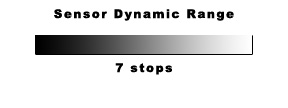In the first posting we discussed how colors are translated into three numbers in a digital camera, one for each of the three primary colors – Red, Green and Blue (RBG for short). After all, digital cameras are computers complete with processors, memory and software. We described the 8 bit color mode in which the numbers range from 0 to 255 and are used to measure and store the brightness of each color. Zero is darkest dark possible and 255 is the brightest bright possible. When all three colors are combined in equal proportions you end up with gray. If all three colors are zeros (0,0,0) you have pure black; if they are all 255s (255,255,255) you have pure white.
Camera Sensor Dynamic Range
The next step in this journey of understanding it to realize how the pixels in the camera sensor work. Recall that each pixel is really three pixels – one for each of the primary colors. While the following is an oversimplification, suffice it to say that the sensor has a built in dynamic range that can be measured in stops. That is to say, the range from the darkest darks to the brightest brights that the sensor is capable of capturing can be measured in stops. This is also true of all films. For example, the dynamic range may be as little as five stops (generally most color positive films) and as much as ten stops or more (generally the most advanced digital cameras). For the remainder of this discussion we can assume our camera has a dynamic range of 7 stops. It can be illustrated in this way….
Continue reading “High Dynamic Range #2 (HDR)”
(1201)

